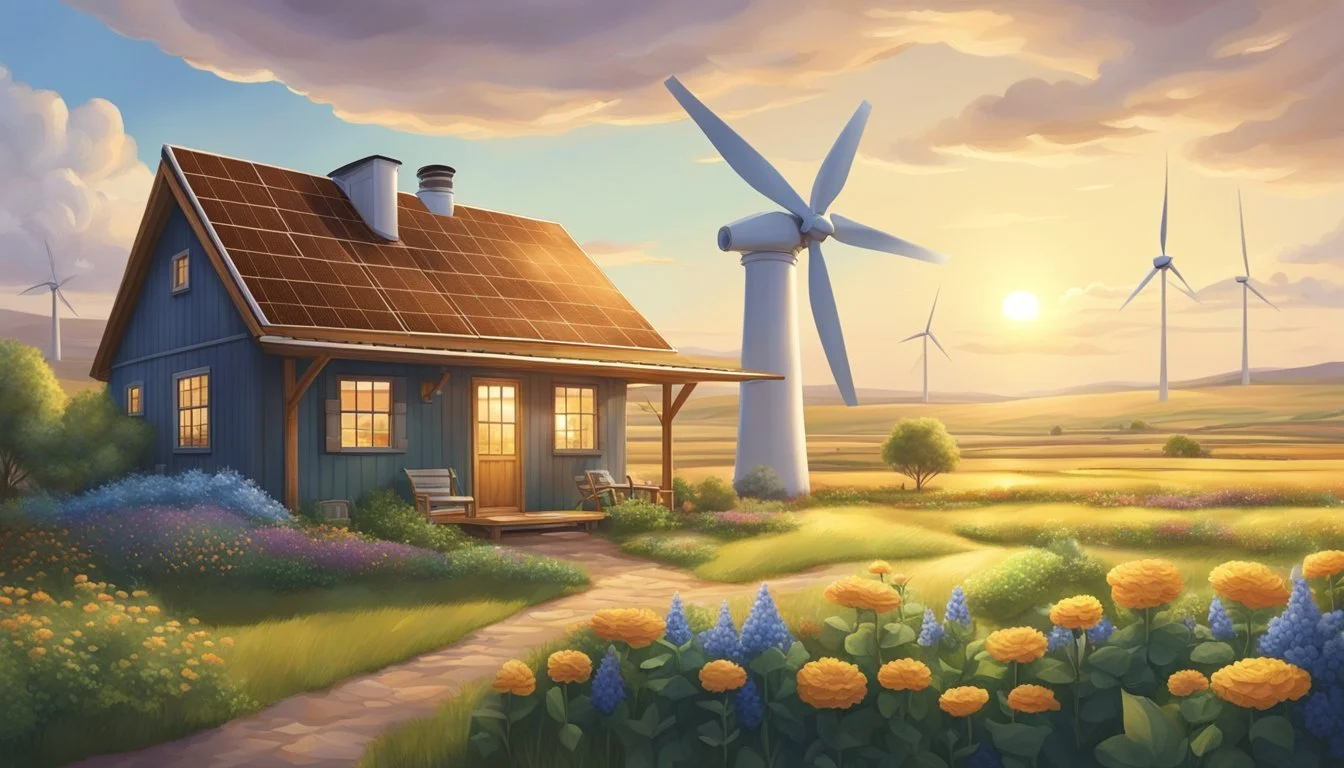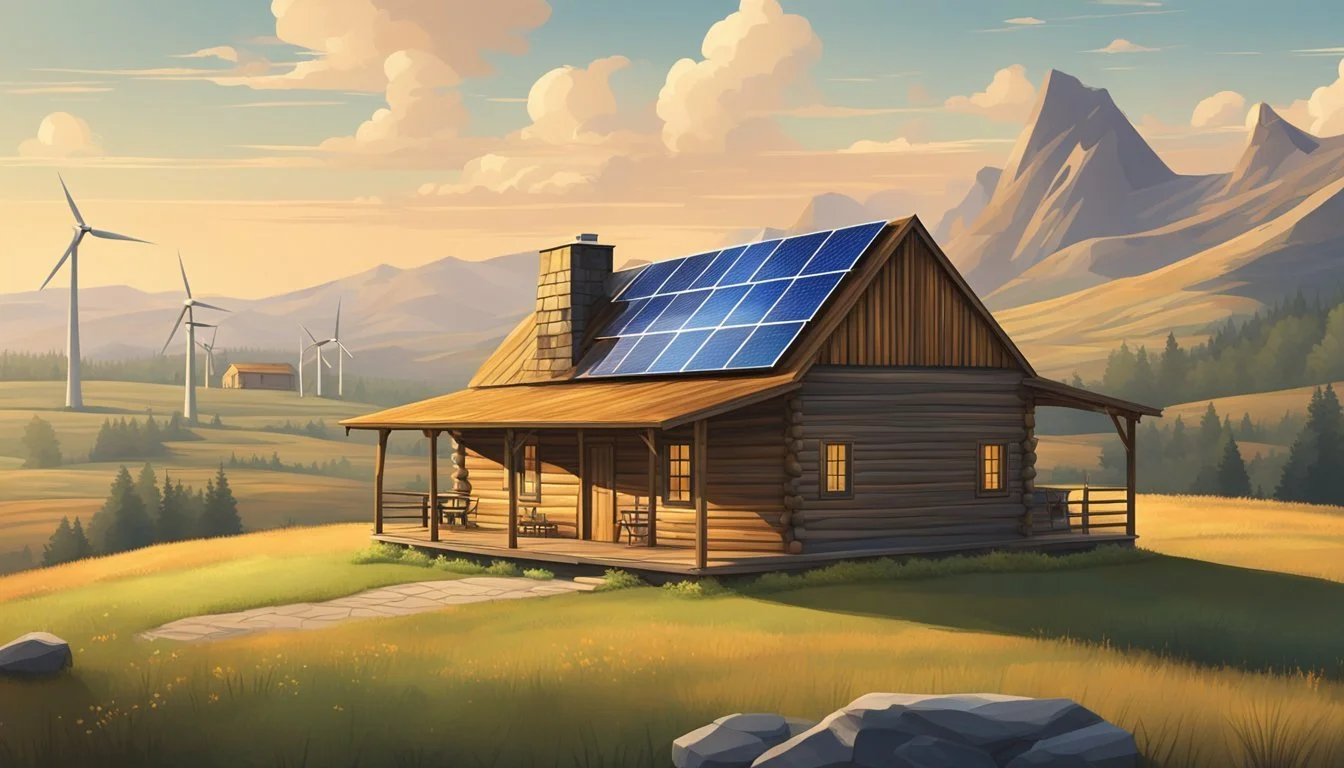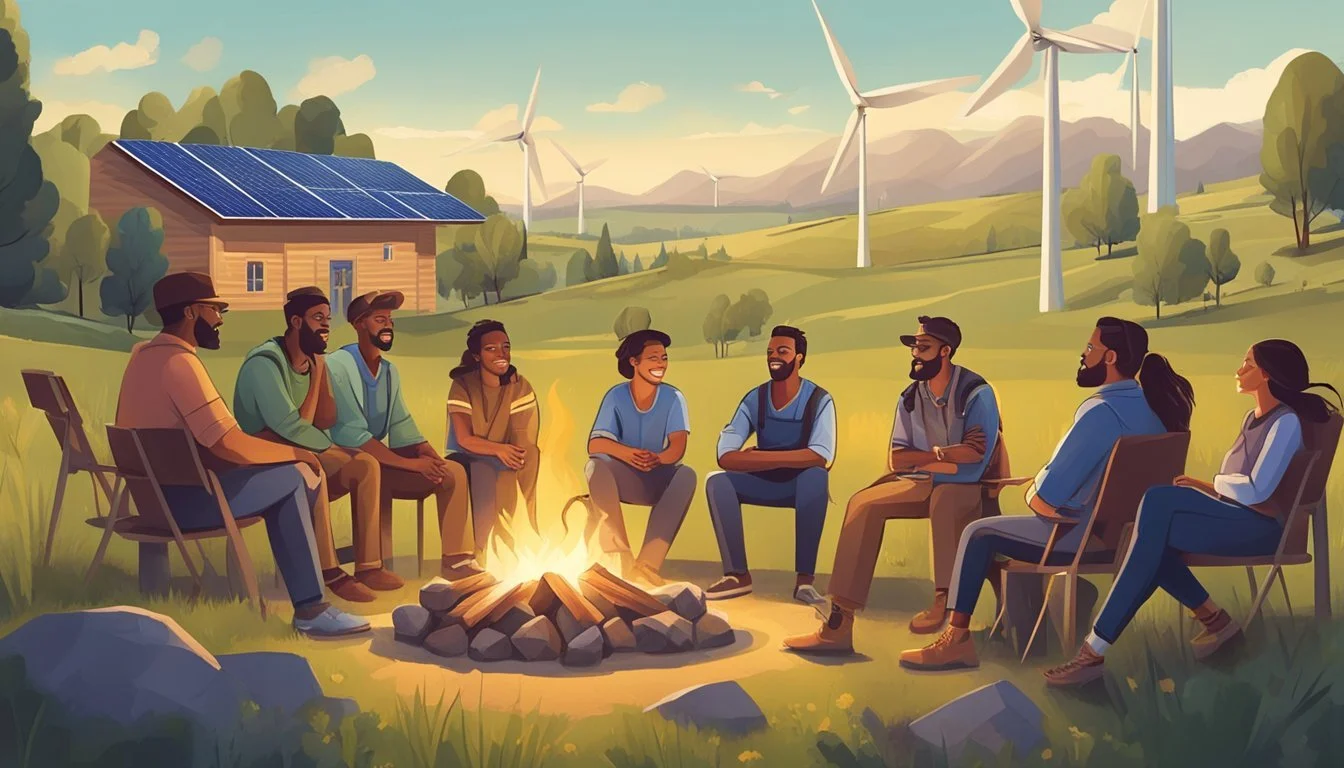Great Plains Off Grid Living
Sustainable Strategies and Solutions
The Great Plains offers an ideal setting for those looking to embrace off-grid living. With its expansive landscapes and low population density, the region provides ample opportunities for sustainability and self-reliance. Energy independence is achievable through wind and solar power, making the Great Plains a prime location for those seeking freedom from conventional utilities.
South Dakota, for instance, stands out with its affordable land prices and extensive wind resources. In counties like Perkins, residents harness wind energy to power their homes, illustrating the viable and efficient use of renewable resources. The region's vast, open spaces not only support agricultural ventures but also offer a peaceful retreat from urban life.
The Great Plains promises a lifestyle rich with natural beauty and simplicity. The combination of wide, open land and sustainable living practices creates an environment where people can thrive independently. By choosing off-grid living in this region, one gains the benefits of both privacy and a connection with nature, making it a compelling option for modern homesteaders.
Understanding Off-Grid Living
Off-grid living entails embracing self-sufficiency and sustainability by relying on independent systems for utilities. This practice has both significant benefits and unique challenges that must be thoroughly understood.
Concept and Benefits
Off-grid living is the practice of operating independently from public utilities. This often involves generating power through solar panels or wind turbines, sourcing water from wells or rainwater catchment systems, and managing waste through composting or septic systems.
Benefits:
Environmental Impact: Reduced carbon footprint through renewable energy use and decreased reliance on fossil fuels.
Financial Freedom: Lower utility bills and potential savings in the long term despite initial investments.
Self-Reliance: Being independent for resources like electricity, water, and food promotes resilience and autonomy.
Challenges and Considerations
While off-grid living offers many advantages, it comes with a set of challenges that require careful planning and adaptation.
Challenges:
Initial Investment: Significant upfront costs for renewable energy systems, water management infrastructure, and essential equipment.
Maintenance: Ongoing upkeep and repairs of systems such as solar panels, batteries, and water filtration units.
Skill and Knowledge: Necessity to acquire skills in areas like gardening, renewable energy management, and basic repairs.
Considerations:
Legal & Zoning Regulations: Compliance with local laws and building codes is essential.
Resource Management: Efficient use and conservation of energy, water, and food are crucial.
Isolation: Potential social isolation, which can impact mental health, especially in remote areas.
Off-grid living requires a commitment to sustainability and a willingness to tackle the associated challenges head-on. This lifestyle choice is ideal for those seeking greater control over their resources and a closer connection to nature.
Selecting a Location
When considering off-grid living in the Great Plains, assessing state differences, land costs, climate conditions, and legal requirements is critical. Community resources also play a role in choosing the best location.
State Assessments and Comparisons
Each state in the Great Plains offers unique advantages and challenges for off-grid living. Montana and Wyoming, with their expansive rural areas, are ideal for those seeking solitude and natural beauty. South Dakota, Kansas, and Missouri offer more affordable land and a mix of rural and semi-rural communities, making them attractive for those on a budget. Colorado and New Mexico boast diverse climates and landscapes, appealing to a wide range of preferences. It is essential to research each state's attributes to find the best fit.
Land Availability and Cost
Land prices in the Great Plains vary significantly by location. South Dakota, for instance, has affordable land prices in its western regions (around $500 - $1,500 per acre), which is appealing for budget-conscious homesteaders. In contrast, Colorado and Montana generally have higher land prices due to their popularity and desirable landscapes. Also, consider accessibility to resources and utilities when choosing a plot. Proximity to towns can potentially lower costs for logistics and increase access to community resources.
State Average Land Price per Acre South Dakota $500 - $4,000 Colorado $2,000 - $6,000 Wyoming $1,500 - $3,500
Climate Conditions
The climate in the Great Plains can vary from arid in regions like New Mexico, to continental climates in South Dakota and Kansas with distinct seasons. Montana and Wyoming experience cold winters and mild summers, demanding robust preparation for colder months. When selecting a location, consider the temperature ranges, precipitation levels, and length of growing seasons. This knowledge helps in planning for agricultural activities and energy requirements, ensuring sustainability throughout the year.
Zoning Laws and Building Codes
Understanding local zoning laws and building codes is crucial when planning off-grid living. Some areas may have restrictions on the types of structures you can build, impacting your choice of housing. For instance, Kansas and Missouri rural areas often have more lenient zoning regulations, encouraging off-grid developments. On the other hand, stricter codes in parts of Colorado and Montana may limit certain sustainable practices or alternative energy systems. Confirming these details with local authorities can prevent compliance issues and unforeseen expenses.
Community and Resources
Community support and access to local resources significantly impact off-grid living success. Consider proximity to towns or small communities that offer essential services like healthcare, hardware stores, and educational opportunities. States like South Dakota and Missouri have supportive homesteading communities and co-ops that aid in sharing resources and knowledge. Networking with local groups can provide vital tips on sustainable living and troubleshooting common challenges specific to the region. Additionally, consider regions with access to natural resources such as water bodies or forests for self-sufficiency and emergency needs.
Setting Up Your Off-Grid Home
Embarking on off-grid living in the Great Plains involves careful planning, smart building techniques, access to renewable energy, and efficient waste management. These key areas ensure a sustainable lifestyle independent from public utilities.
Designing and Planning
Initial planning centers on a clear layout and functionality. Maps or design software help visualize placement for water sources, energy systems, and living spaces.
Critical factors include:
Location: Proximity to a natural water source like a lake or well eases water access.
Orientation: South-facing structures maximize solar panel efficiency.
Utility Needs: Identify what renewable energy sources (solar, wind) and waste management systems (composting toilets, septic tanks) fit best.
A detailed house plan ensures all elements integrate seamlessly, fostering long-term sustainability.
Building Techniques and Materials
Construction must withstand the unique Great Plains climate, marked by wind, heat, and storms.
Considerations include:
Materials: Use durable, locally sourced materials such as straw bales, adobe, or reclaimed wood for better thermal mass and insulation.
Techniques: Employ passive solar design principles, which naturally regulate indoor temperature, reducing dependency on external energy.
Permits: Ensure compliance with local building codes, particularly for renewable energy systems like solar panels and wind turbines.
These steps make structures resilient and eco-friendly.
Water Sources and Systems
Reliable water access is crucial.
Main options are:
Wells: Ideal for consistent, underground water, needing a generator or solar pump.
Rainwater Harvesting: Efficiently captures and stores water during rain, suitable for non-potable uses.
Natural Bodies: Lakes or rivers provide abundant supply but need thorough filtration for safe consumption.
Water purification solutions include:
Gravity-based filters
UV sterilizers
Portable purification units
These methods ensure a safe, constant water supply.
Renewable Energy Solutions
Renewable energy caters to your off-grid power needs.
Popular choices:
Solar Power: Solar panels harness sunlight, converting it into electricity. Place panels optimally on rooftops or ground mounts.
Wind Power: Wind turbines generate electricity year-round, particularly effective in windy Great Plains areas.
Generators: Backup generators, preferably running on biofuels, provide additional support during sunless or windless periods.
Combining these technologies maximizes energy independence and reliability.
Waste Management
Effective waste management maintains hygiene and sustainability.
Key methods:
Composting Toilets: Transform human waste into soil conditioner, minimizing water usage.
Septic Systems: Properly treat and dispose of household wastewater, essential in off-grid setups.
Greywater Systems: Reuse water from sinks, showers, and laundry for irrigation, reducing freshwater demand.
These practices ensure eco-friendly waste disposal, supporting a self-sufficient lifestyle in the Great Plains.
Sustainable Living Practices
Sustainable living is integral for those embracing an off-grid lifestyle in the Great Plains. This involves growing food, hunting and fishing, preserving food, and managing livestock to ensure self-sufficiency.
Growing Food and Gardening
In the Great Plains, gardening plays a crucial role in sustainable living. Due to short growing seasons, selecting appropriate crops is vital. Cold-hardy vegetables such as cabbage, kale, carrots, and beets can thrive in this climate. Raised beds and greenhouses extend the growing season and protect plants from harsh weather.
Crop Rotation improves soil fertility and prevents disease.
Composting supplies essential nutrients.
Drip Irrigation conserves water while ensuring plants receive adequate hydration.
Seed Saving and heirloom varieties preserve plant diversity and ensure future harvests.
Hunting and Fishing
Hunting and fishing provide significant protein sources for off-grid residents. Deer, turkey, and small game are abundant in the Great Plains. Adopting ethical hunting practices ensures wildlife populations remain stable.
Fishing in local lakes and rivers offers diverse fish species such as trout, catfish, and bass.
Regulations: Always comply with local wildlife regulations to maintain sustainability.
Preservation Techniques: Smoking, drying, and salting can keep meat and fish viable for long periods without refrigeration.
Proper gear and training are essential for safety and efficiency.
Food Preservation
Preserving food ensures a reliable supply throughout the year, particularly during harsh winters. Techniques include canning, drying, and fermenting.
Canning: Sterilized jars preserve fruits, vegetables, and meats.
Drying: Dehydrators or solar drying methods extend the shelf life of various foods.
Fermenting: This method not only preserves but also enhances nutritional value.
Root Cellars: Store root vegetables, apples, and winter squash in a cool, dark place.
Proper labeling and rotation of preserved foods prevent waste and ensure freshness.
Livestock and Animal Husbandry
Raising livestock provides a renewable source of meat, milk, eggs, and other products. Suitable animals for the Great Plains include chickens, goats, sheep, and cattle.
Chickens: Offer eggs and meat. Coops should be predator-proof.
Goats: Supply milk and are excellent at grazing.
Sheep and Cattle: Provide meat, milk, and wool. Manage pastures to prevent overgrazing.
Sustainable Practices: Implement rotational grazing, natural feed, and humane treatment.
Proper housing, fencing, and care routines ensure animal health and productivity.
Incorporate these practices to achieve a sustainable, self-sufficient lifestyle on the Great Plains.
Legal and Financial Considerations
Living off-grid in the Great Plains involves navigating various legal and financial factors. These include securing property rights, managing tax obligations, and budgeting for insurance, utilities, and other essential resources.
Understanding Property Rights and Taxes
Securing land for off-grid living involves understanding property rights and zoning regulations. Land in unincorporated county areas is typically more lenient regarding off-grid setups.
Zoning laws vary widely and can impact the feasibility of building and living off-grid.
Property taxes can be less burdensome for off-grid properties, as they often lack municipal services like water and sewage.
However, owners must still comply with local regulations and building codes, which can include restrictions on water rights and land use.
Insurance and Liability
Off-grid living requires careful consideration of insurance needs. Standard home insurance may not cover off-grid properties due to unique risks and non-traditional setups. Owners should seek specialized insurance policies that cover alternative energy systems, water collection, and self-sufficient structures.
Liability coverage is also crucial, especially for properties that may host visitors or renters.
Adequate insurance ensures that damages or legal issues do not become financially crippling. Additionally, understanding the extent of coverage and exclusions in policies is paramount for off-grid homeowners.
Financial Planning for Off-Grid Living
Financial planning for off-grid living must account for the cost of alternative energy systems, water collection, and storage infrastructure. Solar panels, wind turbines, and battery storage solutions represent significant investments.
Initial costs can range from $15,000 to $50,000 for power systems alone.
Budgeting for ongoing maintenance and replacement of components is essential. Water rights may necessitate investment in wells or rainwater harvesting systems.
Additionally, potential homeowners should explore financial incentives and tax credits available for renewable energy installations, which can offset initial costs.
Effective financial planning ensures sustainability and mitigates unforeseen expenses, making off-grid living more viable in the long term.
Community and Networking
Building a strong community and effective networking are crucial for those living off the grid in the Great Plains. Establishing a support network and sharing resources can significantly improve the quality, safety, and sustainability of off-grid living.
Forming and Joining Off-Grid Communities
Forming or joining off-grid communities in the Great Plains involves collaboration and shared goals. Newcomers often start by connecting with existing groups or attending regional meetups dedicated to sustainable living. These communities can provide valuable insights and support systems, helping newcomers adapt more efficiently.
Networking Opportunities:
Local Meetups: Regular gatherings to discuss strategies and share experiences.
Online Forums: Platforms where members can exchange tips and troubleshoot issues.
Challenges:
Privacy Concerns: Balancing community involvement with personal privacy.
Regulatory Hurdles: Navigating local laws and regulations that may impact community projects.
Sharing Knowledge and Resources
Sharing knowledge and resources within off-grid communities is essential for success. Residents often engage in mutual aid, helping each other with tasks such as farming, construction, and energy management. This collaboration fosters a resilient and supportive environment.
Knowledge Sharing:
Workshops and Training: Sessions on sustainable practices like permaculture, renewable energy, and water conservation.
Digital Resources: Access to a wealth of information through blogs, videos, and online courses.
Resource Sharing:
Tool Libraries: Common spaces where tools and equipment are shared.
Seed Banks: Exchanges of heirloom seeds to promote diverse and adapted crops.
Effective networking and resource sharing not only enhance the living standards but also strengthen the community's independence and resilience.
Emergency Preparedness
Preparedness is essential when living off the grid in the Great Plains due to the region’s susceptibility to natural disasters and isolation from traditional resources. Proper planning includes backup systems, weather contingencies, and adequate healthcare supplies.
Backup Systems and Contingencies
Living off-grid requires reliable backup systems for power and water. Solar panels and wind turbines are common renewable energy sources. A generator serves as a crucial backup when these systems fail.
Additionally, storing emergency water supply and having a filtration system ensures access to clean water. It's essential to periodically inspect and maintain all backup systems to ensure functionality when needed most.
Backup Energy Sources:
Solar panels
Wind turbines
Water Resources:
Stored water tanks
Filtration systems
Weather and Natural Disasters
The Great Plains are prone to severe weather, such as tornadoes, blizzards, and floods. Residents should build or designate a storm shelter. Regular updates of emergency kits with essentials like food, water, and necessary equipment is advised.
Knowledge of weather patterns and having a weather radio ensures timely alerts. Evacuation plans should be clear and practiced regularly, ensuring all family members know their roles and responsibilities during an emergency.
Key Preparations:
Storm shelter
Emergency kits
Weather radio
Healthcare and First Aid
Remote living necessitates a well-stocked first aid kit and basic medical supplies. Individuals should have training in basic first aid and CPR.
Storing medications and having access to emergency medical contact numbers is critical. Arrangements with nearby medical facilities or telemedicine services can provide additional support during medical emergencies.
Essential Medical Supplies:
First aid kit
Basic medications
Emergency contact numbers
In summary, thorough emergency preparedness plans ensure safety and resilience for off-grid living in the Great Plains. These measures protect against power outages, water shortages, natural disasters, and health emergencies.
The Future of Off-Grid Living
Advancements in technology, evolving regulations, and a growing focus on sustainability are shaping the future of off-grid living. From innovative energy solutions to changing policies, these factors are paving the way for a more viable and sustainable off-grid lifestyle.
Technological Innovations
Technological advancements are revolutionizing off-grid living. Renewable energy solutions like solar panels and wind turbines are becoming more efficient and affordable, providing reliable off-grid electricity.
Battery storage systems are improving, enabling better energy management and backup.
Water harvesting technologies are also advancing. Systems for collecting and purifying rainwater are more efficient, ensuring a stable water supply independent of municipal resources.
Smart home technologies enhance the off-grid experience, allowing for remote monitoring and management of energy and resources. These innovations are making off-grid living more accessible and sustainable.
Evolving Regulations and Policies
Regulations and policies are evolving to support off-grid living. Governments and municipalities are increasingly recognizing the benefits of renewable energy and off-grid systems, leading to more favorable policies.
In many areas, building codes are being updated to facilitate off-grid construction, making it easier for homeowners to attain necessary permits.
Incentives and grants for installing renewable energy systems are becoming more common, reducing the financial barriers to off-grid living. These regulatory changes are crucial for the widespread adoption of off-grid lifestyles, ensuring that off-grid homes meet safety standards while still promoting sustainability.
The Role of Off-Grid Living in Global Sustainability
Off-grid living plays a significant role in global sustainability efforts. Relying on renewable energy sources reduces dependence on fossil fuels, lowering greenhouse gas emissions. This shift is crucial in combating climate change.
The movement promotes resource efficiency and self-sufficiency, encouraging individuals to minimize waste and make environmentally conscious decisions.
Communities adopting off-grid practices often engage in sustainable agriculture and water conservation, contributing to overall ecological health.
Educational initiatives and community projects focused on off-grid living are spreading awareness and knowledge, helping more people understand and adopt sustainable practices.










